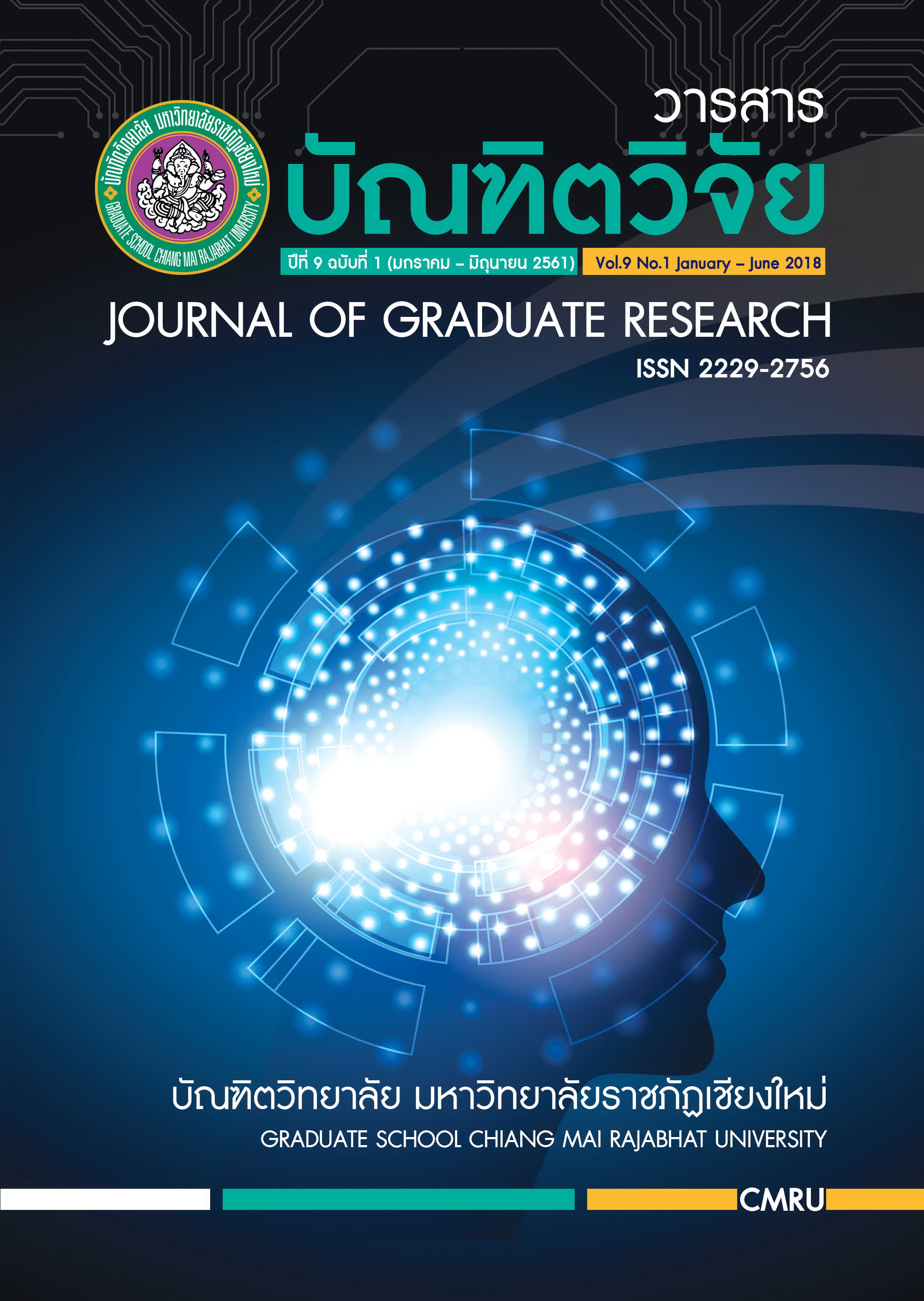A Model of Learner-Centered Instruction to Promote Critical Thinking Skills and Academic Achievement in Psychology Courses for Students in Faculty of Education, Chiang Mai Rajabhat University
Main Article Content
Abstract
The purposes of this study were to investigate the current states of learner-centered approach promoting critical thinking skills and to develop a model of the learner-centered instructions to promote critical thinking skills and academic achievement in psychology courses. The population was a group of 12 faculty members in Department of Psychology, Chiang Mai Rajabhat University. The research instrument was the questionnaire inquiring on towards current states of learner-centered approach. The statistics used for the data analysis were arithmetic mean and standard deviation. The results revealed that:
- The opinions on the current states of learner-centered approach was found at a high level. The first aspect was learning-centered teaching, whereas the last aspect was management of classroom atmosphere promoting critical thinking skills.
- The model of the learner-centered instructions to promote critical thinking skills and academic achievement in psychology courses consisted of four components as follows:
2.1 Lesson plans including (1) learning objectives, (2) instructional procedures and nine techniques of learner-centered instructional activities: inquiry-based learning, case study, role playing, cooperative learning, 4 MAT teaching, learning center, problem-based learning, project-based learning, and research-based learning, (3) conclusion and application, and (4) evaluation
2.2 Classroom management promoting thinking skills should include flexible as well as friendly atmosphere and appropriate physical classroom management. Teachers” roles should include preparing for class, creating psychological safety climate, respecting learners’ ideas, accepting new ideas, and facilitating learners. Learners’ roles should include setting learning goals, having positive attitudes towards learning, being inquisitive and observant, and having a sense of humor
2.3 The critical thinking test consisted of 42 items of 16 scenarios including critical thinking processes and according to critical thinking behaviors with the IOC between .67 and 1.00 and the reliability (Cronbach’s coefficient alpha) of .45
2.4 The achievement tests in five psychology courses: Psychology for Teaching Profession, Psychology of Individual Differences, Research in Psychology, Learning Management of Sex Education, and Introduction to Industrial and Organizational Psychology, were objective tests with the Index of Item – Objective Congruence (IOC) between .67 - 1.00, and at least 60 percent of all items in the test had the proper value of difficulty (P-value), and at least 40 percent of all items in the tests met the criterion of discrimination (R-value) (r ≥ .20), with reliability (KR-20) between .70 - .95.
Downloads
Article Details
References
ปฎิคม พงษประเสริฐ. (2550). การศึกษาการจัดสภาพแวดล้อมและการบริการในโรงเรียนเทศบาลสังกัดเทศบาลเมืองนครนายก. (สารนิพนธ์การศึกษามหาบัณฑิต, สาขาวิชาการบริหารการศึกษา บัณฑิตวิทยาลัย มหาวิทยาลัยศรีนครินทรวิโรฒ).
ประยุทธ์ ไทยธานี. (2551). ผลการใช้การตั้งคำถามตามแนวคิดหมวกคิดหกใบที่มีต่อการคิดอย่างมีวิจารณญาณของนักศึกษาครู. สืบค้นจาก www.old.nrru.ac.th/grad/datateacher.php?id=181
พรทิพย์ ศิริภัทราชัย. (2556). STEM Education กับการพัฒนาทักษะในศตวรรษที่ 21. สืบค้นจาก https://www. tci-thaijo.org/index.php/executivejournal/article/view/80766/64305
ยศ ทรัพย์เย็น. (2547). การศึกษาความสัมพันธ์ระหว่างกิจกรรมการเรียนการสอนระดับอุดมศึกษากับความคิดอย่างมีวิจารณญาณของนิสิตมหาวิทยาลัยเกษตรศาสตร์ ชั้นปีที่ 4 วิทยาเขตบางเขนและวิทยาเขตกำแพงแสน. สืบค้นจาก www.tnrr.in.th/2558/?page=result_search&record_id=242688
ศิวภรณ์ สองแสน, สมบัติ คชสิทธิ์, บุญเชิด ภิญโญอนันตพงษ์, และฐิติพร พิชยกุล. (2557). การพัฒนาการคิดอย่างมีวิจารณญาณสำหรับนักศึกษาสาขาการศึกษาปฐมวัยโดยรูปแบบ MAPLE. สืบค้นจาก https://www.tci-thaijo.org/index.php/JournalGradVRU/article/download/.../21659
สุรศักดิ์ สินประกอบ. (2557). การพัฒนารูปแบบการเรียนโดยใช้ปัญหาเป็นฐานบนสื่อสังคมออนไลน์ร่วมกับเทคนิคการสืบค้นข้อมูลเพื่อส่งเสริมความสามารถในการคิดอย่างมีวิจารณญาณของนิสิตปริญญาบัณฑิต. สืบค้นจากhttps://thesis.grad.chula.ac.th/current.php?mode=show&id=5583446827
สำนักงานคณะกรรมการการศึกษาแห่งชาติ. (2544). คู่การจัดการศึกษาสำหรับผู้มีความสามารถพิเศษด้านทักษะความคิดระดับสูง. กรุงเทพฯ: บริษัทรัตนพรชัย จำกัด.
สำนักงานคณะกรรมการการอุดมศึกษา. (2556). แผนพัฒนาการศึกษาระดับอุดมศึกษา ฉบับที่ 11 (พ.ศ.2555-2559). กรุงเทพฯ: โรงพิมพ์แห่งจุฬาลงกรณ์มหาวิทยาลัย.
อารี พันธ์มณี. (2545). ฝึกคิดให้คิดเป็นคิดให้สร้างสรรค์. กรุงเทพฯ: ใยไหม.
อุษา ปราบหงส์. (2550). การพัฒนาทักษะการคิดอย่างมีวิจารณญาณในรายวิชาพฤติกรรมมนุษย์กับการพัฒนาตนสำหรับนักศึกษามหาวิทยาลัยราชภัฏสกลนคร. สืบค้นจาก https://research.rdi.ku.ac.th/forest/Search.aspx?keyword
องอาจ นัยพัฒน์. (2553). การวัดประเมินในชั้นเรียน: วิวัฒนาการและแนวคิดใหม่เพื่อพัฒนาการเรียนรู้. วารสาร
ศรีนครินทรวิโรฒวิจัยและพัฒนา (สาขามนุษยศาสตร์และสังคมศาสตร์) E-Journal, 2(3), 1-10. สืบค้นจาก http://ejournals.swu.ac.th/index.php/swurd/article/view/903


